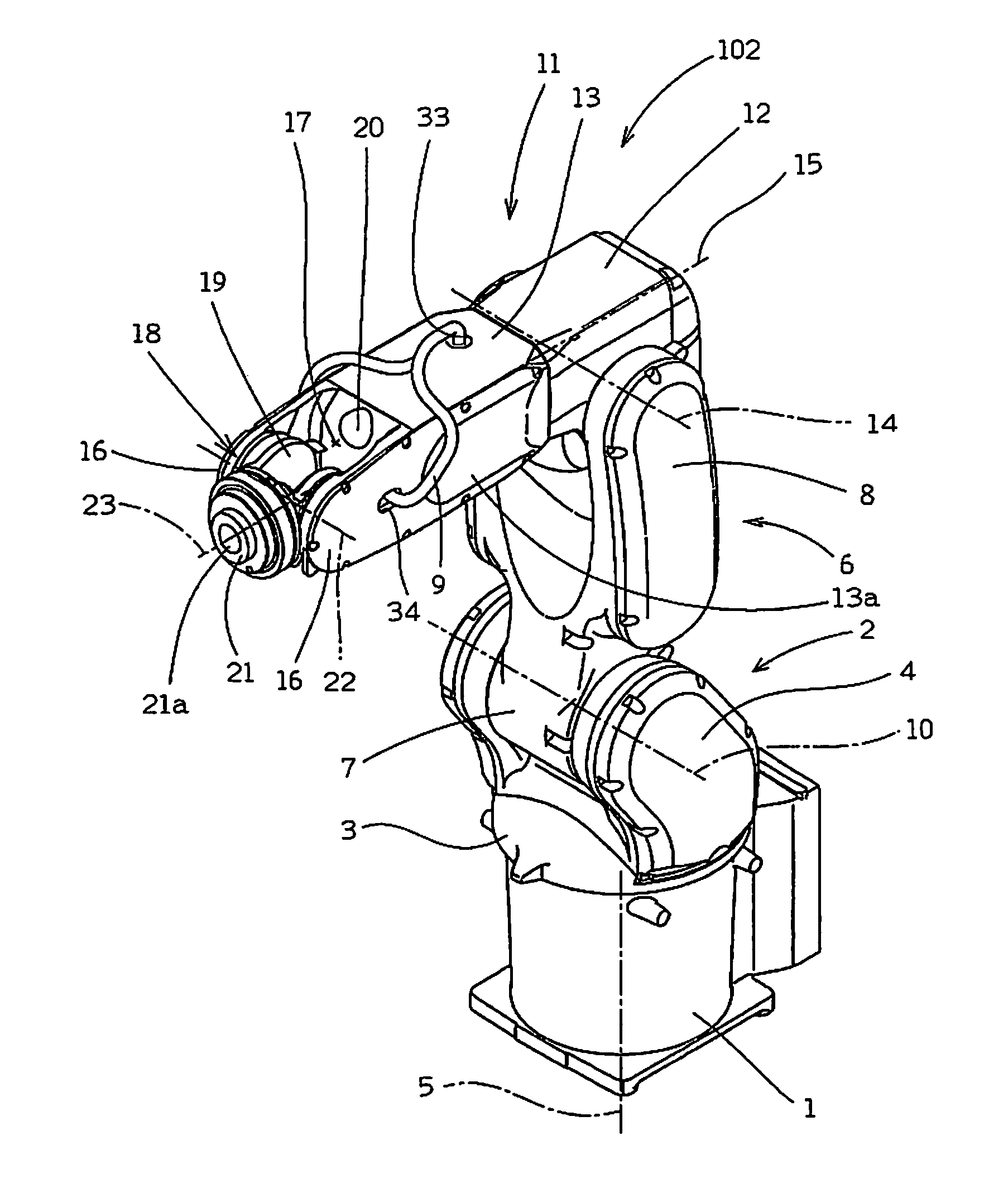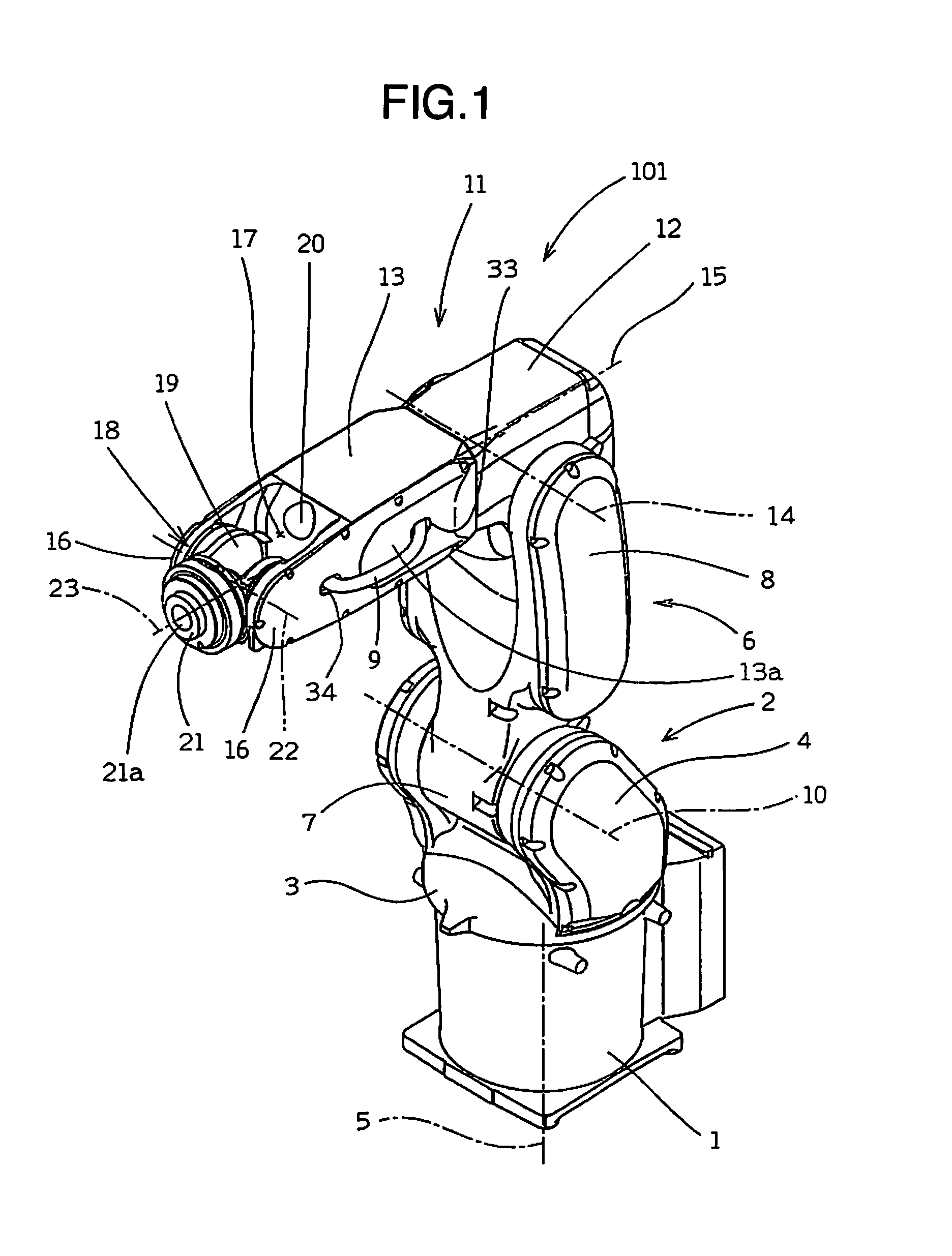Industrial robot
a robot and industrial technology, applied in the field of industrial robots, can solve the problems of line breakage, resistance to arm and/or wrist pivoting, and risk of damage, and achieve the effect of not increasing the slack of a cable, facilitating the installation of a cable, and reducing the outside appearan
- Summary
- Abstract
- Description
- Claims
- Application Information
AI Technical Summary
Benefits of technology
Problems solved by technology
Method used
Image
Examples
embodiment 1
[0032]First, a general configuration of a robot 101 according to a first embodiment will be described. As shown in FIG. 1, a frame 2 is placed on a base 1 which is installed on an installation surface such as a floor surface. This frame 2 includes a base plate part 3 disposed on an upper surface of the base 1, and a pair of stand plate parts 4 which stand obliquely upward from peripheral edges of the base plate part 3, respectively. Moreover, a motor (not shown) for pivotally moving the entire frame 2 in a horizontal plane (in a plane parallel with the floor surface) is attached to the upper surface of the base plate part 3. By rotating the motor shaft of the motor in a predetermined direction, the frame 2 pivots about a first pivot axis 5 provided perpendicular to the installation surface.
[0033]A lower half part of a lower arm 6 is attached between the pair of stand plate parts 4 of the frame 2. The lower half part of the lower arm 6 has a substantially cylindrical shape and consti...
embodiment 2
[0049]In the case of the robot 101 according to the first embodiment, the single first hole 33 and the single second hole 34 are provided only in the sidewall part 13a on one side of the second upper arm part 13. In contrast to this, in a robot 102 according to a second embodiment shown in FIG. 5, one first hole 33 is provided in an upper wall part 13b of the second upper arm part 13, and a second hole 34 is provided in each of a pair of sidewall parts 13a. In the case of this robot 102, the cable 9 drawn from the first hole 33 of the second upper arm part 13 is branched into two directions, each of the branched cables 9 is drawn into the wrist arrangement portion 17 through the corresponding second hole 34, and thereafter the cables 9 are integrated with each other to pass through a through hole 21a of the wrist 18. In the case of the robot 102 according to the second embodiment, even if the outer diameter of the cable 9 increases, the work of installing the cable 9 to the wrist 18...
embodiment 3
[0050]In a robot 103 according to a third embodiment shown in FIG. 6, a first hole 33 and a second hole 34 are provided in each of a pair of sidewall parts 13a of the second upper arm part 13. In the robot 102 according to the second embodiment, the cable 9 is branched off after being passed through the first hole 33. In contrast to this, the robot 103 according to the third embodiment has a configuration in which the cable is branched off before it is passed through the first hole 33 (namely, within a second accommodating portion 28 of the second upper arm part 13). The robot 103 according to the third embodiment achieves the same effect as that of the robot 102 according to the second embodiment.
[0051]In the robots 101 to 103 according to the first to third embodiments herein, description has been made on the case in which the cable 9 extends in the surroundings of the upper arm 11. However, the cable 9 may extend in the same manner not only in the upper arm 11 but also in the low...
PUM
 Login to View More
Login to View More Abstract
Description
Claims
Application Information
 Login to View More
Login to View More - R&D
- Intellectual Property
- Life Sciences
- Materials
- Tech Scout
- Unparalleled Data Quality
- Higher Quality Content
- 60% Fewer Hallucinations
Browse by: Latest US Patents, China's latest patents, Technical Efficacy Thesaurus, Application Domain, Technology Topic, Popular Technical Reports.
© 2025 PatSnap. All rights reserved.Legal|Privacy policy|Modern Slavery Act Transparency Statement|Sitemap|About US| Contact US: help@patsnap.com



